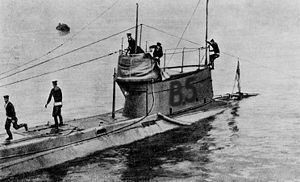Name HMS B5 Launched 14 November 1905 Test depth 30 m | Completed 25 February 1906 Beam 12 ft 7 in (3.8 m) Length 43 m Draft 3.4 m | |
 | ||
Fate Sold for scrap, 25 August 1921 Displacement 287 long tons (292 t) surfaced316 long tons (321 t) submerged | ||
HMS B5 was one of 11 B-class submarines built for the Royal Navy in the first decade of the 20th century. She survived World War I and was sold for scrap in 1921.
Contents
Design and description
The B class was an enlarged and improved version of the preceding A class. The submarine had a length of 142 feet 3 inches (43.4 m) overall, a beam of 12 feet 7 inches (3.8 m) and a mean draft of 11 feet 2 inches (3.4 m). They displaced 287 long tons (292 t) on the surface and 316 long tons (321 t) submerged. The B-class submarines had a crew of two officers and thirteen ratings.
For surface running, the boats were powered by a single 16-cylinder 600-brake-horsepower (447 kW) Vickers petrol engine that drove one propeller shaft. When submerged the propeller was driven by a 180-horsepower (134 kW) electric motor. They could reach 12 knots (22 km/h; 14 mph) on the surface and 6.5 knots (12.0 km/h; 7.5 mph) underwater. On the surface, the B class had a range of 1,000 nautical miles (1,900 km; 1,200 mi) at 8.7 knots (16.1 km/h; 10.0 mph).
The boats were armed with two 18-inch (45 cm) torpedo tubes in the bow. They could carry a pair of reload torpedoes, but generally did not as they would have to remove an equal weight of fuel in compensation.
Construction and career
B5 was built by Vickers at their Barrow-in-Furness shipyard, launched 14 November 1905 and completed 25 February 1906. When the war began in 1914, the boat was assigned to defend the Straits of Dover. B5 was sold on 25 August 1921 to AJ Anderson, then sold again on 1 March 1922 to J Smith, Poole.
